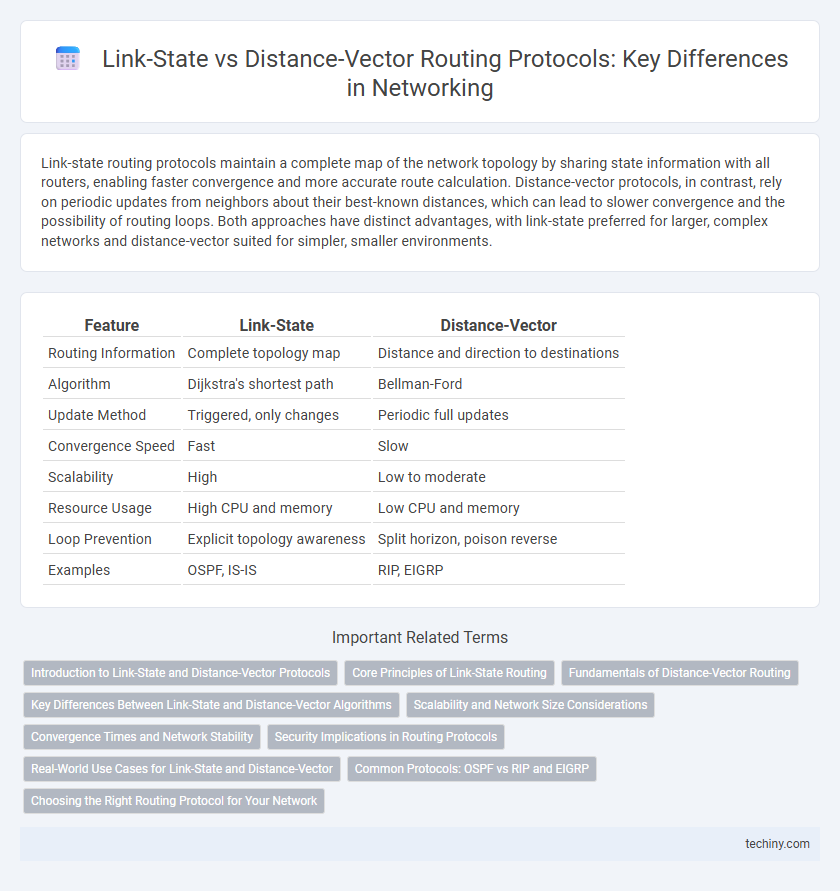Link-state routing protocols maintain a complete map of the network topology by sharing state information with all routers, enabling faster convergence and more accurate route calculation. Distance-vector protocols, in contrast, rely on periodic updates from neighbors about their best-known distances, which can lead to slower convergence and the possibility of routing loops. Both approaches have distinct advantages, with link-state preferred for larger, complex networks and distance-vector suited for simpler, smaller environments.
Table of Comparison
| Feature | Link-State | Distance-Vector |
|---|---|---|
| Routing Information | Complete topology map | Distance and direction to destinations |
| Algorithm | Dijkstra's shortest path | Bellman-Ford |
| Update Method | Triggered, only changes | Periodic full updates |
| Convergence Speed | Fast | Slow |
| Scalability | High | Low to moderate |
| Resource Usage | High CPU and memory | Low CPU and memory |
| Loop Prevention | Explicit topology awareness | Split horizon, poison reverse |
| Examples | OSPF, IS-IS | RIP, EIGRP |
Introduction to Link-State and Distance-Vector Protocols
Link-state and distance-vector protocols are essential methods for routing data in networks, each utilizing distinct algorithms to determine optimal paths. Link-state protocols, such as OSPF, maintain a comprehensive map of the network topology by flooding link-state advertisements, enabling routers to compute shortest paths using Dijkstra's algorithm. Distance-vector protocols, like RIP, rely on routers sharing distance vectors with neighbors, updating routes based on hop counts and periodically exchanging complete routing tables to propagate network changes.
Core Principles of Link-State Routing
Link-state routing protocols maintain a comprehensive map of the entire network topology by exchanging link-state advertisements (LSAs) with all routers in the area, enabling each router to independently calculate the shortest path using algorithms like Dijkstra's. This approach ensures fast convergence and accurate route computation, minimizing routing loops and reducing network overhead. Core principles include periodic flooding of link-state information, synchronization of link-state databases, and precise path selection based on real-time topology data.
Fundamentals of Distance-Vector Routing
Distance-vector routing relies on routers sharing their entire routing tables with immediate neighbors to determine the best path, using hop count as the primary metric. This protocol periodically updates routes, which can lead to slower convergence and susceptibility to routing loops without mechanisms like split horizon or poison reverse. Examples include Routing Information Protocol (RIP), emphasizing simplicity and low overhead in small to medium-sized networks.
Key Differences Between Link-State and Distance-Vector Algorithms
Link-state algorithms maintain a complete map of the network topology by exchanging link-state advertisements with neighbors, enabling each router to independently calculate the shortest path using Dijkstra's algorithm. Distance-vector algorithms rely on periodic updates from neighbors containing the distance to destinations, using the Bellman-Ford algorithm to update routing tables with limited network knowledge. Link-state protocols provide faster convergence and scalability, while distance-vector protocols are simpler but prone to routing loops and slower updates.
Scalability and Network Size Considerations
Link-state routing protocols, such as OSPF, offer superior scalability for large and complex networks by maintaining a complete topology map and supporting hierarchical designs with areas. Distance-vector protocols like RIP struggle with scalability due to periodic full routing updates and limited hop count, making them suitable mainly for smaller networks. Link-state's efficient handling of large topology changes and rapid convergence enhance performance in sizable networks, whereas distance-vector's simplicity limits its use as network size grows.
Convergence Times and Network Stability
Link-state protocols typically exhibit faster convergence times compared to distance-vector protocols due to their use of complete network topology maps, enabling routers to rapidly compute optimal paths after a change. Distance-vector protocols rely on periodic updates and incremental information sharing, which can delay convergence and increase the risk of routing loops during topology changes. Faster convergence in link-state protocols enhances overall network stability by quickly adapting to failures and preventing prolonged routing inconsistencies.
Security Implications in Routing Protocols
Link-state routing protocols, such as OSPF and IS-IS, offer enhanced security mechanisms by authenticating routing updates and using cryptographic checksums to prevent tampering, reducing the risk of route injection attacks. Distance-vector protocols like RIP are more susceptible to spoofing and routing loops due to their reliance on periodic broadcasts without strong authentication methods, increasing vulnerability to malicious actors. Implementing secure key management and employing protocol-specific authentication methods are crucial to mitigating these security threats in both routing types.
Real-World Use Cases for Link-State and Distance-Vector
Link-state routing protocols like OSPF and IS-IS are commonly deployed in large enterprise and ISP networks where fast convergence and scalability are critical, enabling efficient topology updates and minimizing routing loops. Distance-vector protocols such as RIP and EIGRP are preferred in smaller, simpler networks due to their ease of configuration and lower resource requirements, making them suitable for branch offices or legacy systems. Real-world implementations showcase link-state protocols optimizing complex, hierarchical networks while distance-vector protocols serve well in stable, less dynamic environments.
Common Protocols: OSPF vs RIP and EIGRP
OSPF, a link-state protocol, maintains a complete map of the network topology to calculate the shortest path using Dijkstra's algorithm, ensuring fast convergence and scalability in large networks. RIP, a distance-vector protocol, uses hop count as its metric with a maximum limit of 15 hops, making it suitable for smaller, simpler networks but prone to slow convergence and routing loops. EIGRP combines features of both, employing a distance-vector approach enhanced with diffusing update algorithms for rapid convergence and scalable network design.
Choosing the Right Routing Protocol for Your Network
Selecting the appropriate routing protocol depends on network size, complexity, and convergence needs. Link-state protocols like OSPF provide faster convergence and better scalability for large, dynamic networks, while distance-vector protocols such as RIP are simpler and suitable for smaller, less complex environments. Evaluating factors like bandwidth, CPU resources, and administrative overhead ensures optimal routing efficiency and reliability.
Link-state vs Distance-vector Infographic

 techiny.com
techiny.com